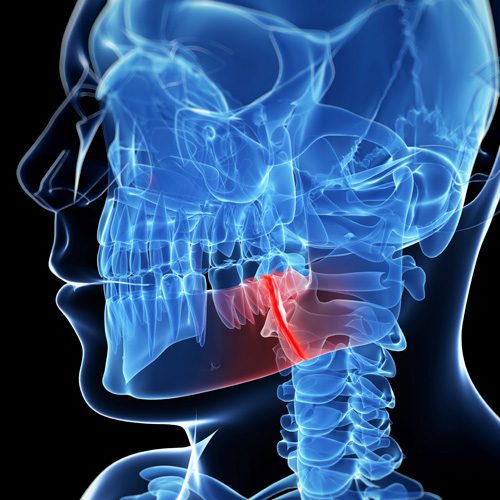The jaw is one of the most complex and most frequently used systems in the body. Just think about going one day or even more than 8 hours without talking, chewing, or eating and you’ll be reminded of how important its functionality is. With how much we use our jaw it should come as no surprise that more than 10 million people are diagnosed with TMJ (Temporomandibular Joint Disorder) in the US.
TMJ typically comes with chronic jaw pain and clicking, headaches, and neck pain and usually stems from a bite that’s slightly off, a jaw dislocation/injury, or arthritis in the joints.
What we were surprised to find out was that because of the complexities of the system, many people go undiagnosed or are treated incorrectly, which can lead to a slew of problems long-term. We spoke to Dr. Michael Gunson who specializes in correctional jaw surgeries to get to the root of these prevalent problems.
“It’s not a well understood problem and it’s definitely an underdiagnosed problem” said Gunson as he explained the complexities of the system that leads to joint pain.
 “The obvious cases that are the bread and butter of this diagnosis is where a child will go into the orthodontist and the parent will realize the teeth aren’t lining up so the orthodontist takes a look and the teeth don’t line up. But, there are reasons the teeth don’t line up. It could be crooked teeth but it could also be that the bones are either growing too much or failing to grow as they’re supposed to.” Gunson continues. “And, when the discrepancies show up in the bones then the orthodontist’s hands are more tied. They can do a little bit of effort to move the parts but to get things to fit a little bit better, but once the bones are off significantly, they can’t get things to fit. And so, this surgery was developed as a means of aligning the teeth over each other by moving the bones into their correct position.”
“The obvious cases that are the bread and butter of this diagnosis is where a child will go into the orthodontist and the parent will realize the teeth aren’t lining up so the orthodontist takes a look and the teeth don’t line up. But, there are reasons the teeth don’t line up. It could be crooked teeth but it could also be that the bones are either growing too much or failing to grow as they’re supposed to.” Gunson continues. “And, when the discrepancies show up in the bones then the orthodontist’s hands are more tied. They can do a little bit of effort to move the parts but to get things to fit a little bit better, but once the bones are off significantly, they can’t get things to fit. And so, this surgery was developed as a means of aligning the teeth over each other by moving the bones into their correct position.”
Surgery is typically seen as a last resort option to fix a problem, and for good reasons. It’s costly both with our wallets and our time. Though, Dr. Gunson is there for when surgery is simply the best option to cure long term problems. His consultation with his patients typically last around two to three hours so that he can explain the system to the patient and give a proper diagnosis. At least that way, when they go to get a second opinion, they know the anatomy of their jaw and how each part is affecting one another, and they are in a far better position to ask the right questions.
He and his partner also developed the FAB Treatment to properly diagnose the patient’s whole system rather than one portion of the problem.
Facial. Airway. Bite. The three things that the surgery focuses on fixing.
Facial
“There are a lot of different kinds of malinformation that show up in people like the lower jaw doesn’t grow enough so the chin is back a bit or the upper jaw doesn’t grow enough so it looks like the patients got an enormous lower jaw with nothing up top” said Dr. Gunson.
These growth abnormalities can sometimes lead to patient’s being unable to fully close their lips. The over exhaustion the jaw muscles being pushed just to touch the lips together is what can cause chronic pain over time. In one instance Dr. Gunson used lip fillers so his patient’s lips could touch together more easily and her jaw clicking and muscle pain eventually subsided.
 Airway
Airway
One of Dr. Gunson’s patients was experiencing jaw and muscle pain so she was sent to an orthodontist who told her that her lower jaw was off. She went to get a second opinion with Dr. Gunson who had a 2 hour consultation with her. He was able to find out that it was actually her upper jaw that was off and it was also causing her sleep apnea. Her upper jaw was blocking the airway path which was making it more difficult for her to breath at night on top of her muscle pain.
Dr. Gunson mentioned that a blocked airway can be a very common problem that results from misaligned jaw bones.
Bite
Many who are diagnosed with TMJ go into a clinic who will prescribe a splint to realign the patient’s bite and give some ease to the jaw joints. In many cases, in a period of 6-8 months, the patient experiences no further pain. Though sometimes, another splint is required. The patient is out more money and the problem is persisting. In these cases, surgery is required.
What’s tricky about this subject is that some patients can go to the grave with a biologically off jaw, yet they don’t experience pain, so they don’t need to cure the problem. However, for those who do experience chronic pain, Dr. Gunson recommends taking a look at the whole system rather than just one part.
“It’s very short sided to think that a mouth full of 32 teeth, a tongue and lips and airway and the face that has to animate and all the joints that have to function together, you can’t treat one part of it and ignore the other ones.” said Dr. Gunson.




